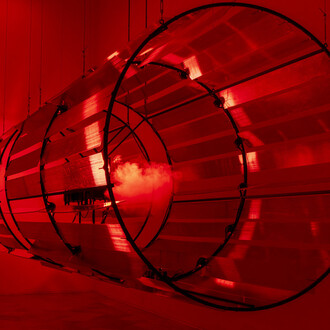Silence is the great art of conversation.
(Hélène Cixous)
Silence is the most perfect sound, a pause that says the unspeakable.
(Jean-Luc Nancy)
Ignasi Aballí, renowned for his conceptual approach and meticulous exploration of themes such as silence and painting, with a career spanning several decades, has developed a visual language that fosters reflection and contemplation.
The title In ictu oculi, translated from Latin as "In the blink of an eye" encapsulates the fleeting nature of time and the ephemeral essence of human existence. This expression derives from one of the celebrated vanitas by the Baroque artist Juan de Valdés Leal. Vanitas, an artistic genre that evokes the inevitability of death and the transience of material things, reminds us of life´s fragility and how quickly it can change or end.
In ictu oculi at the CAAC, Centro Andaluz de Arte Contemporáneo focuses on two key concepts: silence and reflections on painting. Silence in Aballí's work is not simply the absence of sound but an active presence that encourages deep contemplation and introspection. Through empty spaces, monochromatic colors, and ephemeral materials, the artist creates a dialogue with the monastic history and the tradition of spiritual contemplation of the Carthusian monastery and Seville.
Painting, in its essence and materiality, constitutes another central pillar in his work. Through reflection on pigments, technique, and the creative process, Aballí questions and redefines contemporary painting practice. His work leads us to reconsider the nature of painting and its relevance in the current context.
The exhibition is organized into rooms that explore specific aspects of Ignasi Aballí's work. The themes include the blink, symbolizing the intermittence of visual perception and the fleetingness of time; the visible and invisible, challenging our notions of perception and reality; and the relationship between text and image, questioning how we understand and represent the world through different languages. Additionally, the exhibition addresses error and correction, reflecting on the creative process and the acceptance of imperfection. This structure allows for a deep and detailed exploration of the various facets of his work.
Among the most representative works are pieces that employ diverse techniques and materials, from pigments and unpainted canvases to site-specific interventions with subtle gestures that play with visual perception. Each space and each work offer a unique perspective on the concepts of silence and painting.
In ictu oculi aims to create an experience of introspection and contemplation. Through his works, Aballí challenges us to reflect on the nature of art and our perception of the world, generating a “silent conversation” that is powerful and profound with the audience.
The history of the Carthusian monastery, headquarters of the CAAC, adds an additional layer of meaning, having historically been a place of silence and meditation. This context further enriches the visitor's experience, situating Aballí's work in a continuous conversation with the past and present of art, as well as with the contemplative and spiritual practices.
















